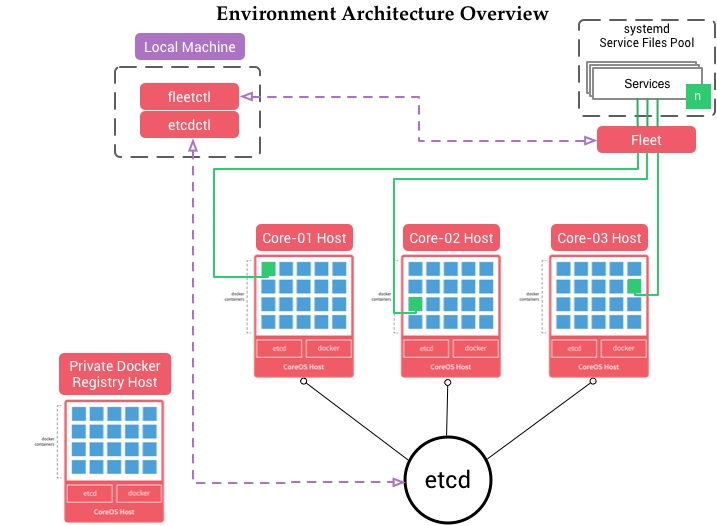#CoreOS + Docker Development Environment Demo
This is a reference environment showing how CoreOS and Docker can be set up in a local environment.
- Environment Architecture Diagram
- Environment Setup
- Examples
- Simple Getting Started Usage
- Ambassadors
- etcd, systemd, and Fleet
- Disk Space
- Notes
- Tips and Tricks
- Useful Documentation
-
Install Vagrant 1.5.4+ and either VirtualBox 4.3.10+ or VMware Fusion 5.0.4+ - for VMware you must purchase a license for the Vagrant Vmware provider plugin ~$79.00
-
Install CoreOS host tools for Fleet and Etcd
## Install etcdctl $ brew install go etcdctl ## Build and install fleetctl $ git clone https://github.com/coreos/fleet.git $ cd fleet && ./build ## You may need to create the /usr/local/bin path on OSX Mavericks and ## put it in your path if it doesn't exist already $ mv bin/fleetctl /usr/local/bin ## Test that etcdctl and fleetctl work $ etcdctl -v $ fleetctl -v
-
Clone repo and CD to directory:
git clone https://github.com/MarkMoudy/coreos-docker-CI-demo.git && cd coreos-docker-CI-demo -
Generate new etcd cluster discovery token(IMPORTANT You must do this everytime you bring up a fresh cluster):
# Use the script $ ./preinstall.sh # or $ cp config/vendor/coreos-vagrant/user-data.sample config/vendor/coreos-vagrant/user-data && \ DISCOVERY_TOKEN=`curl -s https://discovery.etcd.io/new` && \ perl -p -e "s@#discovery: https://discovery.etcd.io/<token>@discovery: $DISCOVERY_TOKEN@g" \ config/vendor/coreos-vagrant/user-data.sample > config/vendor/coreos-vagrant/user-data
-
Bring up Cluster using Vagrant with either the VirtualBox or VmWare Fusion Provider:
## you will have to enter your password for the NFS Shared folders ## Using VirtualBox $ vagrant up ## Using VmWare Fusion(Must have paid license key and plugin installed) $ vagrant up --provider vmware_fusion
-
Set fleetctl tunnel environment variable to manage cluster:
FLEETCTL_TUNNEL=127.0.0.1:4001 -
Use fleetctl to check for machines in cluster
fleetctl list-machines
I have included several demo examples for using a CoreOS cluster.
- Deploying Multiple Static Web Services on a CoreOS cluster
- Deploying Redis on CoreOS using Dynamic Ambassadors Demo
There are several use cases represented with this demo using Fleetctl and systemd:
- Starting a container remotely
- Building and pushing a container to a private registry
- Creating a container using systemd
Once you have the environment setup you can use the fleetctl client to push systemd .service files to the cluster. Fleet is a distributed init system that sits on top of etcd and systemd to make intraction with the cluster easier. There are several systemd unit files located in the services/ directory. Start by using fleetctl to push dillinger.service to the cluster.
$ fleetctl submit services/dillinger.service
# You can view the files sent to fleet with the fleetctl list-units command
$ fleetctl start dillinger.serviceIf you run the command fleetctl journal dillinger.service you can see the logs from the container and if you navigate in your browser to the ip address of the node that the service was started on at port 3000(192.168.2.<replace>:3000), you will see that dillinger is running.
I have set up a private docker registry running at 192.168.2.90 which should come up when you start the cluster. An important piece of pushing images to a private registry is that you have to tag the Docker image with the ip and port. If you look in the init-build.sh script you can see the commands to build a jenkins container image from a Dockerfile.
Etcd uses systemd unit files to define the service that you are launching. Below is an example of how this would work for the Jenkins container image:
[Unit]
Description=Jenkins Docker Service
Requires=docker.service
After=docker.service
After=etcdctl.service
[Service]
ExecStart=/usr/bin/docker run -p 80:8080 192.168.2.90:5000/moudy/jenkins
ExecStartPost=/usr/bin/etcdctl set /cidemo/%p/%H:%i running
ExecStop=/usr/bin/docker stop 192.168.2.90:5000/moudy/jenkins
ExecStopPost=/usr/bin/etcdctl rm /cidemo/%p/%H:%i
ExecStartPost - this sets the key/value of the service to etcd and is using modifiers to fill in the path. More Info
Ambassadors are containers who's sole purpose is to help connect containers across multiple hosts. See Redis-demo service files for an example.
You can use sidekick systemd unit files to register and de-register services to etcd. Using the Jenkins service as an example, there are two files to inspect [email protected] and jenkins-discovery.1.service. jenkins-discovery.1.service announces the jenkins service to etcd and removes the key after stopping. Use fleet to start [email protected] and jenkins-discovery.1.service. Then check etcd with etcdctl ls --recursive and you should see something like:
$ etcdctl ls --recursive
/services
/services/ci
/services/ci/jenkins1Then get the contents of the key with fleetctl ssh <machine_id> etcdctl get /services/ci/jenkins1 and you should see:
# replace f49b7ee7 with any one of your <machine_ids> found with fleetctl list-machines(they should all return the same values)
etcdctl get f49b7ee7 /services/ci/jenkins1
{ "host": "core-02", "port": "80" }Docker uses a union based file system so it only stores the differences of images and containers on the filesystem which is an important part of the layers concept. An example of how much disk space that docker uses on my cluster with most of the images I have built being pushed to the cluster looks like this:
$ sudo du -hsxc share/.vagrant/machines/* 2>/dev/null
2.6G share/.vagrant/machines/core-01
2.3G share/.vagrant/machines/core-02
2.6G share/.vagrant/machines/core-03
1.1G share/.vagrant/machines/core-04
8.0K share/.vagrant/machines/coreos-alpha
3.6G share/.vagrant/machines/docker_registry
8.0K share/.vagrant/machines/vmware_fusion
13G totalSo we can infer from this that with careful pruning of older docker images, cleaning up stopped containers, and using externally mounted volumes for data hungry containers we can do a lot with minimal disk space.
See this blog post about where docker stores data.
- CoreOS has a Chaos Monkey deal implemented so the nodes will randomly shut down and kick you out. Use vagrant to reload the node that crashed to get the shared folders back. Fix
- Docker - list last used container by setting:
alias dl='docker ps -l -q'. Use in any command by replacing containerID with`dl` - Docker - Delete all stopped containers:
alias cdel='docker rm $(docker ps -a -q)' - set both
alias dl='docker ps -l -q'; alias cdel='docker rm $(docker ps -a -q)'
